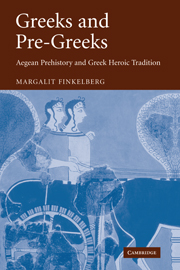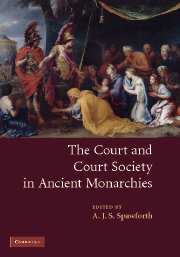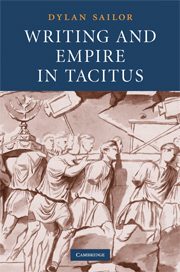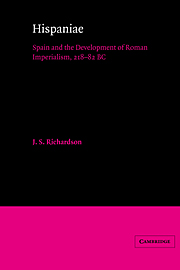Refine search
Actions for selected content:
24021 results in Ancient history

Greeks and Pre-Greeks
- Aegean Prehistory and Greek Heroic Tradition
-
- Published online:
- 22 September 2009
- Print publication:
- 05 January 2006

The Court and Court Society in Ancient Monarchies
-
- Published online:
- 22 September 2009
- Print publication:
- 04 October 2007

Writing and Empire in Tacitus
-
- Published online:
- 22 September 2009
- Print publication:
- 02 October 2008

Hispaniae
- Spain and the Development of Roman Imperialism, 218–82 BC
-
- Published online:
- 07 September 2009
- Print publication:
- 18 December 1986
List of tables
-
- Book:
- From Hellenism to Islam
- Published online:
- 01 March 2010
- Print publication:
- 03 September 2009, pp ix-ix
-
- Chapter
- Export citation
9 - Religion and language in Dura-Europos
-
-
- Book:
- From Hellenism to Islam
- Published online:
- 01 March 2010
- Print publication:
- 03 September 2009, pp 235-254
-
- Chapter
- Export citation
List of figures
-
- Book:
- From Hellenism to Islam
- Published online:
- 01 March 2010
- Print publication:
- 03 September 2009, pp viii-viii
-
- Chapter
- Export citation
6 - Continuity of Nabataean law in the Petra papyri: a methodological exercise
-
-
- Book:
- From Hellenism to Islam
- Published online:
- 01 March 2010
- Print publication:
- 03 September 2009, pp 154-174
-
- Chapter
- Export citation
3 - Euergetism in Josephus and the epigraphic culture of first-century Jerusalem
-
-
- Book:
- From Hellenism to Islam
- Published online:
- 01 March 2010
- Print publication:
- 03 September 2009, pp 75-92
-
- Chapter
- Export citation
Introduction: documentary evidence, social realities and the history of language
-
-
- Book:
- From Hellenism to Islam
- Published online:
- 01 March 2010
- Print publication:
- 03 September 2009, pp 1-12
-
- Chapter
- Export citation
5 - Ritual performances of divine justice: the epigraphy of confession, atonement, and exaltation in Roman Asia Minor
-
-
- Book:
- From Hellenism to Islam
- Published online:
- 01 March 2010
- Print publication:
- 03 September 2009, pp 115-153
-
- Chapter
- Export citation
13 - The Jewish magical tradition from late antique Palestine to the Cairo Genizah
-
-
- Book:
- From Hellenism to Islam
- Published online:
- 01 March 2010
- Print publication:
- 03 September 2009, pp 324-342
-
- Chapter
- Export citation
Contents
-
- Book:
- From Hellenism to Islam
- Published online:
- 01 March 2010
- Print publication:
- 03 September 2009, pp v-vii
-
- Chapter
- Export citation
List of abbreviations
-
- Book:
- From Hellenism to Islam
- Published online:
- 01 March 2010
- Print publication:
- 03 September 2009, pp xxi-xxx
-
- Chapter
- Export citation
4 - Legal and social status of threptoi and related categories in narrative and documentary sources
-
-
- Book:
- From Hellenism to Islam
- Published online:
- 01 March 2010
- Print publication:
- 03 September 2009, pp 93-114
-
- Chapter
- Export citation
15 - Greek inscriptions in transition from the Byzantine to the early Islamic period
-
-
- Book:
- From Hellenism to Islam
- Published online:
- 01 March 2010
- Print publication:
- 03 September 2009, pp 352-373
-
- Chapter
- Export citation
Preface
-
- Book:
- From Hellenism to Islam
- Published online:
- 01 March 2010
- Print publication:
- 03 September 2009, pp xiv-xx
-
- Chapter
- Export citation
Part IV - LINGUISTIC METAMORPHOSES AND CONTINUITY OF CULTURES
-
- Book:
- From Hellenism to Islam
- Published online:
- 01 March 2010
- Print publication:
- 03 September 2009, pp 255-256
-
- Chapter
- Export citation
Part I - THE LANGUAGE OF POWER: LATIN IN THE ROMAN NEAR EAST
-
- Book:
- From Hellenism to Islam
- Published online:
- 01 March 2010
- Print publication:
- 03 September 2009, pp 13-14
-
- Chapter
- Export citation
17 - Greek, Coptic and the ‘language of the Hijra’: the rise and decline of the Coptic language in late antique and medieval Egypt
-
-
- Book:
- From Hellenism to Islam
- Published online:
- 01 March 2010
- Print publication:
- 03 September 2009, pp 401-446
-
- Chapter
- Export citation
